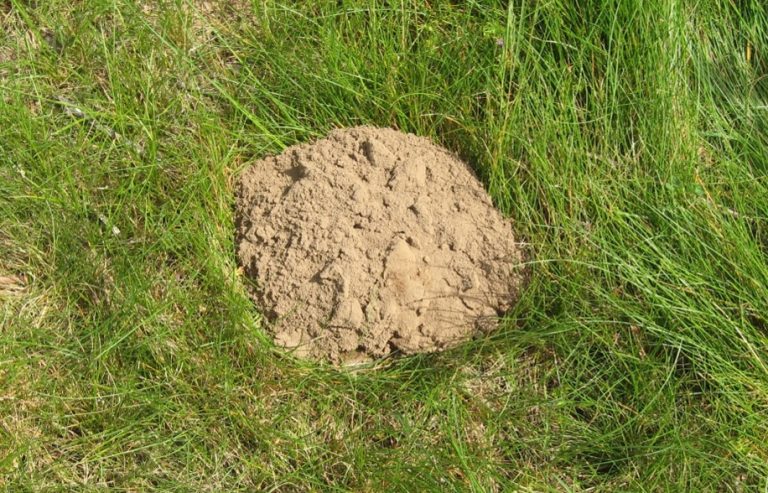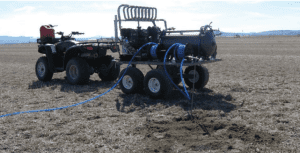
Pocket gophers stay active year-round wreaking havoc in vineyards and other irrigated land, but they can be particularly menacing in late winter or early spring when their breeding activity peaks. Thus, it’s crucial to think about management strategies now before it’s too late and populations are out of control.
Pocket gophers are rarely seen aboveground so calculating exact number of rodents in the vineyard can be difficult, but their burrow system is what gives them away. Under their obvious fan-shaped soil mounds over tunnel openings are typically hundreds of square feet of main tunnels with lateral branches.
In terms of damage, pocket gophers feed off vine taproots or belowground bark on vine trunks, killing young vines or reducing vigor on old ones if feeding is extensive enough. They also damage subsurface drip irrigation. According to UCCE Wildlife Specialist Roger Baldwin at the recent Grape and Wine meeting in November 2022, gopher mounds themselves can also kill vines, create weed seed beds and are a physical hazard in the vineyard.
Pocket gopher management, like most other forms of pest management, utilizes an integrated approach with different tools and strategies. “Mixing and matching these tools is generally going to give you a better result than if you were to rely on just one,” Baldwin said.
Currently available options for pocket gopher management include biocontrol, habitat modification, baiting, burrow fumigation and trapping. Repellent is one other option that may become more efficacious in the coming years.
Biocontrol with Barn Owls
Biocontrol is becoming more and more popular as an option for pest control today as chemical options continue to dwindle. In the case of pocket gophers, the barn owl, a predatory raptor species, will hunt them when present in the owl’s feeding territory; however, Baldwin said that barn owls are not a particularly territorial species.
While barn owls have been efficacious for control of other rodent types, results are inconclusive for pocket gophers. In vineyards, barn owl boxes can be erected to create a home for the owls to live in and breed.
“[Recent studies] have shown potential to reduce pocket gophers in a particular area, so that part is somewhat encouraging,” Baldwin said. “However, we do have to keep in mind that even if they provide some reduction in gophers, they’re certainly not going to eliminate gophers.
“That’s their food resource; if they eliminate it, they’ll have nothing to feed on.
“If you want to include them as part of an IPM program, I think that’s okay, that’s a good strategy, but I wouldn’t rely on them as your sole tool.”
Habitat Modification
Altering the desirable area for a particular species is the basis of habitat modification, Baldwin said, and pocket gophers utilize in-row cover and weeds as food sources.
In grape growing areas where gopher populations are high, it might be beneficial to remove cover crops and control weeds in order to reduce food for gophers. “It’s important to remember these nitrogen-fixing plants are good food sources for gophers and other rodents,” Baldwin said. “If you can shift away from some of these nitrogen-fixing plants to grasses that are less desirable, then that can potentially limit the densities of gophers that you get in a particular area.

Many vineyards utilize nitrogen-fixing cover crops as they provide multiple benefits to plant and soil health in the long term, so removing them to control gophers could be a detriment in certain situations, thus Baldwin noted it can be a balancing act of which benefit outweighs which negative more in a given vineyard.
Important to note is not just modifying the food source but also the burrows themselves for gopher management. Once gophers are controlled, their burrows remain, and new populations can spring up fast if they are allowed to use existing burrows to establish. Baldwin recommended deep ripping to remove burrow systems.
Repellents
In general, according to Baldwin, repellants have not worked well for controlling rodents in field or orchard settings, noting that often repellents require periodic reapplication in order to maintain efficacy, which can be costly and laborious.
One possible application for rodent control using repellents is reducing damage to surface drip irrigation (SDI) from pocket gophers. SDI has become a popular irrigation option throughout the state, but Baldwin said that gopher damage is one of the biggest hurdles for greater implementation.
“The depth of the drip tape is usually at the perfect level for gophers, so they come through and chew quite extensively on this drip tape,” he said. “This creates situations like substantial flooding which leads to all kinds of issues.”
Baldwin said that he and researchers have begun to look at the potential of running a repellent through the water during an irrigation event to move gophers out of a particular area. A product called Protec-T (active ingredient is methyl mercaptan) became registered in California within the last two years.
“We’ve just begun to look at the efficacy of this. What we’ve seen so far is a 41% reduction in gopher numbers. It’s not getting rid of gophers, but it is reducing the number in the field.”
Baldwin said that they haven’t studied this method enough to determine whether damage is reduced on SDI, but he believes that the possibility of damage reduction is promising.
“We haven’t had a chance to do it yet, but we need to measure the number of strikes on drip tape. That’s the most important thing that we need to measure right now,” he said.
Burrow Fumigation and Trapping
In the last few years, California has legalized carbon monoxide machines, sometimes referred to as pressurized exhaust machines, according to Baldwin, for burrowing rodent control. The devices inject carbon monoxide through hoses into burrowing systems and kill rodents.

Research conducted by Baldwin and others revealed that between 56% and 68% efficacy could be achieved for gophers across various soil conditions.
“The efficacy we observed with the PERC machine in dry soil conditions is much better than we would expect with more traditional burrow fumigants like gas cartridges or aluminum phosphide, and they seem to work as well or better than these same fumigants in ideal moist soil conditions,” Baldwin said. “So, I do think that these kinds of pressurized exhaust machines are probably very effective for ground squirrels and relatively effective for gophers.”
Trapping also appears to be highly efficacious in vineyards for pocket gophers. Traps are the most tried-and-true method of gopher control, Baldwin said.
“[In research], we saw 92% to 94% removal rates across two trapping sessions with the Gophinator trap,” Baldwin said, adding that trapping is also one of the most cost-effective control methods due to the high efficacy.











